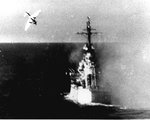Chocks away!
Senior Airman
Well i agree that it seems unlikely because of his lack of armament, but the man claims he actually saw them crash! not just smoke. And i have respect for Japanese aces 8)RG_Lunatic said:I find it at best dubious. The Ki-43-I Hayabusa was, at best, armed with one Ho-103 12.7mm with ~300 rounds, and one 7.7mm mg with ~500 rounds. Given the description, there just doesn't seem to be enough ammo to support it. B-24's could generally take a lot of 12.7 mm hits, and a tremendous number of 7.7mm hits.
I'd have to see confirmation of the losses on that date to believe it. The Japanese were notorious for false kill claims.
And just what angle would he be "safe" from the B-24 return fire? There isn't one!
=S=
Lunatic



